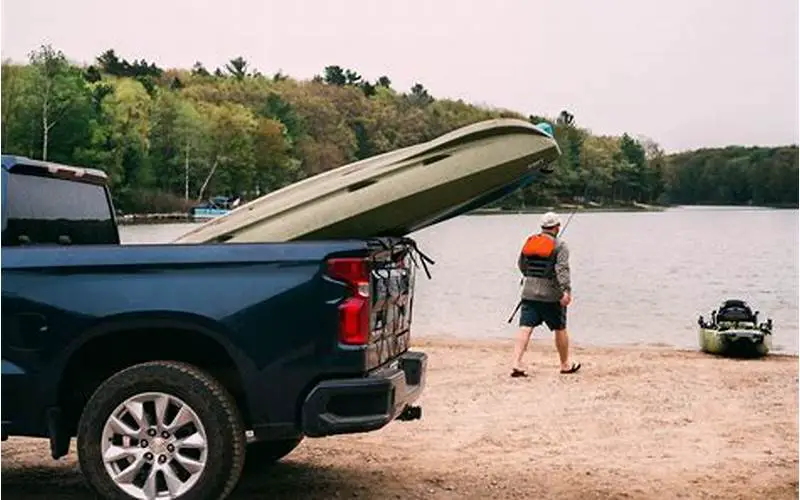
 Source: bing.com
Source: bing.com
Introduction
Hello Truck Owner,
Welcome to our comprehensive guide on transporting kayaks in trucks. Whether you are an adventure enthusiast or a passionate angler, having a reliable method to transport your kayak safely is crucial. In this article, we will explore various techniques, strengths, and weaknesses of transporting kayaks in trucks. So, let’s dive in!
Strengths and Weaknesses of Transporting Kayak in Truck
Strengths
? Convenience: Transporting your kayak in a truck offers convenience and flexibility. You can easily load and unload your kayak whenever and wherever you want.
? Protection: By using proper securing techniques, your kayak remains protected from potential damages during transportation. Unlike roof racks or trailers, trucks provide a shield against external elements.
? Cost-effective: Compared to investing in a specialized kayak trailer, utilizing your truck for transportation can be a cost-effective solution.
? Versatility: Trucks are designed to handle various terrains, allowing you to transport your kayak to remote and challenging locations with ease.
? Accessibility: With your kayak loaded in the truck bed, you have quick and easy access to it. You can launch into the water within minutes, enhancing your overall experience.
? Storage Options: Trucks often come with additional storage options, such as toolboxes or bed extenders, which can be utilized to carry your kayak accessories or fishing gear.
? Fuel Efficiency: Unlike roof-mounted kayak carriers that increase wind resistance and reduce fuel efficiency, transporting your kayak in a truck bed poses minimal impact on the vehicle’s aerodynamics.
Weaknesses
? Limited Space: Depending on the size of your truck bed, you might be limited in terms of the number and size of kayaks you can transport. This can be a drawback for larger groups or when you need to carry multiple kayaks.
? Bed Length: Shorter truck beds might pose challenges in properly securing longer kayaks, potentially exposing them to risks during transportation.
? Bed Liner Protection: If your truck bed lacks a protective liner, there is a chance of scratches or damages to the kayak’s hull. Consider using padding or investing in a quality bed liner.
? Maneuverability: The added height and length of your truck with a kayak loaded can affect maneuverability, especially in tight spaces or when parking.
? Security Concerns: While trucks provide some level of security, it is essential to ensure proper locking mechanisms to prevent theft of your valuable kayak.
? Weather Exposure: Although trucks offer protection from elements, heavy rain or extreme weather conditions can still pose a risk to your kayak. Consider using additional covers for added protection.
? Required Equipment: Properly securing your kayak in a truck requires additional equipment such as ratchet straps, foam blocks, or kayak racks. These accessories add extra cost, but they are crucial for safe transportation.
Complete Information about Transporting Kayak in Truck
| Topic | Details |
|---|---|
| Truck Bed Preparation | Ensure your truck bed is clean, free from debris, and has a protective liner if necessary. |
| Securing Kayak | Use ratchet straps or tie-downs to secure the kayak to the truck bed. Position it parallel to the truck’s length, ensuring it is centered. |
| Kayak Protection | Place foam blocks or pool noodles under the kayak to prevent direct contact with the truck bed, minimizing the risk of scratches. |
| Additional Accessories | Consider using bed extenders, bed racks, or kayak cradles for added stability and security during transportation. |
| Checking Security | Double-check the tightness of straps and the overall stability of the kayak before hitting the road. |
| Driving Considerations | Adapt your driving style, especially when accelerating, braking, or taking turns, to minimize any potential movement of the kayak. |
| Regular Inspections | Periodically check the kayak’s positioning and the tightness of straps during long journeys to ensure continued safety. |
Frequently Asked Questions (FAQs)
1. Can I transport multiple kayaks in my truck?
Yes! However, make sure your truck bed has sufficient space and invest in additional accessories like bed extenders or racks to accommodate multiple kayaks securely.
2. Should I cover my kayak during transportation?
It is recommended to cover your kayak with a waterproof cover to protect it from rain, dust, and other external elements during transportation.
3. How tight should I secure the kayak in the truck bed?
Ensure the kayak is snugly secured without excessive force. Tighten the straps enough to prevent any movement, but avoid damaging the kayak’s hull.
4. Can I transport a kayak in a compact truck?
Transporting a kayak in a compact truck is possible, but you might face challenges due to limited bed length. Consider using a bed extender or opt for a roof-mounted carrier.
5. Are there any legal restrictions for transporting kayaks in trucks?
Regulations regarding kayak transportation vary by region. Check local laws and ensure compliance with any specific requirements, such as proper lighting or flag placement.
6. How often should I inspect the kayak during a long journey?
It is recommended to inspect the kayak’s positioning and the tightness of straps every time you stop for a break during long journeys.
7. Can I use bungee cords instead of ratchet straps?
While bungee cords might seem convenient, they are not recommended for securing kayaks in trucks, as they lack the necessary tension and can easily become loose.
Conclusion
In conclusion, transporting your kayak in a truck offers convenience, protection, and cost-effectiveness. However, it is crucial to consider the strengths and weaknesses associated with this method. By following the proper techniques and utilizing additional accessories, you can ensure a safe and enjoyable journey with your kayak. So, get ready to hit the road and explore new waterways!
Remember to always prioritize safety, regularly inspect your kayak’s security, and adapt your driving style accordingly. Happy kayaking, Truck Owner!
Closing Words
Transporting kayaks in trucks opens up a world of possibilities for outdoor enthusiasts. However, it is essential to understand the limitations and take necessary precautions to ensure a smooth and secure journey. Always invest in high-quality equipment, stay up-to-date with regulations, and never compromise on safety. Enjoy the freedom of exploring stunning water bodies with your trusted truck and kayak combination!
 MyVans Your Vehicle Solution
MyVans Your Vehicle Solution